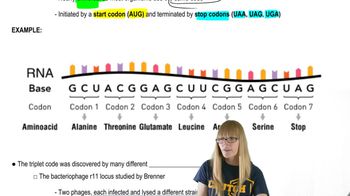The genetic code contains 61 codons to specify the 20 common amino acids. Many organisms carry fewer than 61 different tRNA genes in their genomes. These genomes take advantage of isoaccepting tRNAs and the rules governing third-base wobble to encode fewer than 61 tRNA genes. Use these rules to calculate the minimal number of tRNA genes required to specify all 20 of the common amino acids.
Table of contents
- 1. Introduction to Genetics51m
- 2. Mendel's Laws of Inheritance3h 37m
- 3. Extensions to Mendelian Inheritance2h 41m
- 4. Genetic Mapping and Linkage2h 28m
- 5. Genetics of Bacteria and Viruses1h 21m
- 6. Chromosomal Variation1h 48m
- 7. DNA and Chromosome Structure56m
- 8. DNA Replication1h 10m
- 9. Mitosis and Meiosis1h 34m
- 10. Transcription1h 0m
- 11. Translation58m
- 12. Gene Regulation in Prokaryotes1h 19m
- 13. Gene Regulation in Eukaryotes44m
- 14. Genetic Control of Development44m
- 15. Genomes and Genomics1h 50m
- 16. Transposable Elements47m
- 17. Mutation, Repair, and Recombination1h 6m
- 18. Molecular Genetic Tools19m
- 19. Cancer Genetics29m
- 20. Quantitative Genetics1h 26m
- 21. Population Genetics50m
- 22. Evolutionary Genetics29m
11. Translation
The Genetic Code
Problem 21e
Textbook Question
In an experiment to decipher the genetic code, a poly-AC mRNA (ACACACAC...) is synthesized. What pattern of amino acids would appear if this sequence were to be translated by a mechanism that reads the genetic code as
A quadruplet without overlaps?
 Verified step by step guidance
Verified step by step guidance1
Understand the problem: The poly-AC mRNA sequence (ACACACAC...) is being translated using a mechanism that reads the genetic code as quadruplets (groups of four nucleotides) without overlaps. This means each set of four nucleotides will be treated as a codon to specify an amino acid.
Identify the repeating sequence: The mRNA sequence is poly-AC, which repeats as ACACACAC... indefinitely. This repeating pattern will determine the codons formed when read in quadruplets.
Divide the sequence into quadruplets: Since the translation mechanism reads four nucleotides at a time, the sequence will be divided into codons like ACAC, ACAC, ACAC, and so on.
Determine the amino acid encoded by the codon: Use the genetic code table to identify the amino acid specified by the codon ACAC. Note that the genetic code typically uses triplets, so this step involves understanding how the quadruplet reading frame might alter the standard genetic code interpretation.
Predict the pattern of amino acids: Since the sequence is repetitive and the codon ACAC is consistently formed, the resulting amino acid pattern will also be repetitive, corresponding to the amino acid encoded by ACAC in the quadruplet reading frame.
 Verified video answer for a similar problem:
Verified video answer for a similar problem:This video solution was recommended by our tutors as helpful for the problem above
Video duration:
2mPlay a video:
Was this helpful?
Key Concepts
Here are the essential concepts you must grasp in order to answer the question correctly.
Genetic Code
The genetic code is a set of rules that defines how sequences of nucleotides in DNA and RNA are translated into amino acids, the building blocks of proteins. It consists of codons, which are triplets of nucleotides, but in this case, the question refers to reading the sequence in quadruplets. Each codon corresponds to a specific amino acid or a stop signal during protein synthesis.
Recommended video:
Guided course

The Genetic Code
Translation Mechanism
Translation is the process by which ribosomes synthesize proteins using mRNA as a template. In this experiment, the translation is specified to occur in quadruplets, meaning that every four nucleotides will be read together as a single unit. This differs from the standard triplet reading, which typically results in a different set of amino acids being produced.
Recommended video:
Guided course

Translation initiation
Amino Acid Sequence
The amino acid sequence is the order of amino acids in a protein, which determines its structure and function. In the context of the question, the sequence of amino acids produced from the poly-AC mRNA will depend on how the quadruplets are interpreted. Each unique quadruplet corresponds to a specific amino acid, and understanding this relationship is crucial for predicting the resulting protein structure.
Recommended video:
Guided course

Sequencing Difficulties
Related Videos
Related Practice
Textbook Question
712
views


